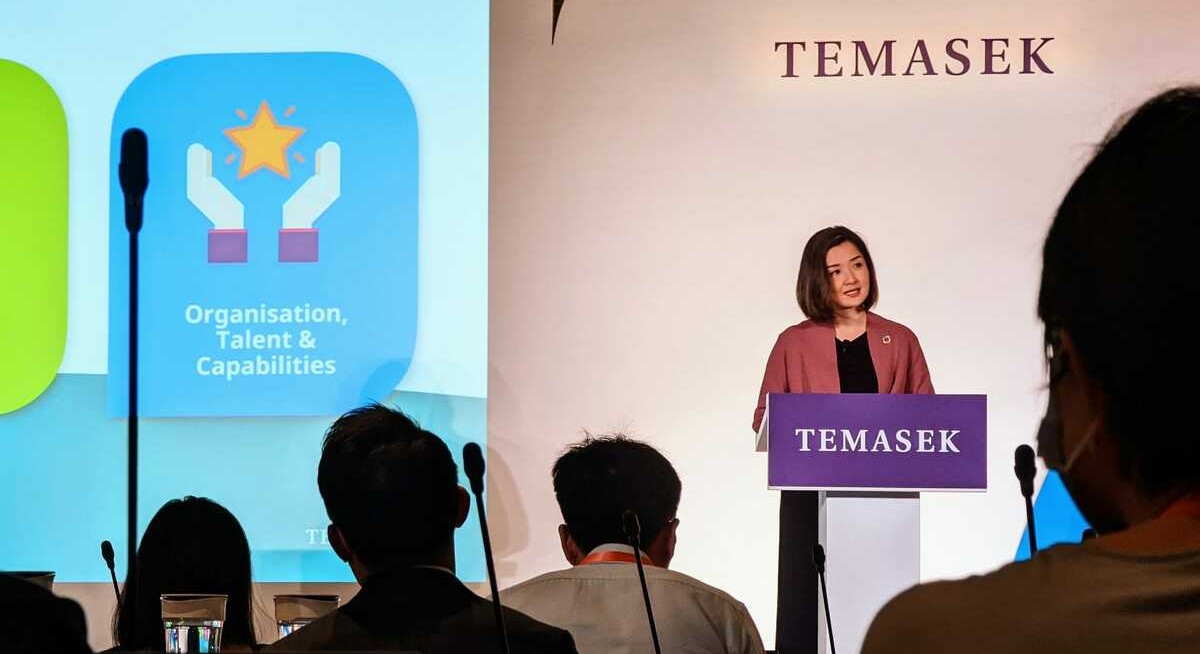Over FY2022, Temasek invested $61 billion and divested $37 billion.
Temasek’s one-year total shareholder return (TSR) was 5.81%, while TSR since its inception in 1974 was an annualised 14% over 48 years. Its 20-year and 10-year TSRs were 8% and 7% respectively, compounded annually.
See also: Temasek launches investment subsidiary GenZero, focused on decarbonisation
Geographical distribution
Across countries, Temasek remains anchored in Asia, which represented 63% of its portfolio in FY2022.
Singapore and China continue to be Temasek’s two largest countries by exposure. 27% of Temasek’s portfolio was based in Singapore in FY2022, up from 24% the previous year, while Temasek’s investments in China fell from a 27% share to 22% in FY2022.
The rest of Asia represented 14% of Temasek’s portfolio in FY2022, up from 13% in the preceding year. The Americas represent 21% of its portfolio, up from 20% the year prior.
Together, Australia and New Zealand remain unchanged in their weightage, as have Europe, Middle East and Africa — the regions represent 4% and 12% of Temasek's portfolio respectively.
Sectoral breakdown
Financial services still make up the majority of Temasek’s portfolio, standing at 23% compared to 24% in FY2021.
Most notably, its investments in telecommunications, media and technology dropped from 21% in FY2021 to 18% in FY2022.
On the other hand, exposure to transportation and industrials increased from 19% to 22% in FY2022, partly because of the additional funds committed to Singapore Airlines’ rescue.
For more stories about where money flows, click here for Capital Section
Unlisted assets
Temasek’s unlisted assets comprised 52% of its portfolio in FY2022.
Temasek’s portfolio value in unlisted assets increased by about four times from $53 billion a decade ago to $210 billion in FY2022.
While unlisted assets include the startups Temasek has invested in, the lion’s share of the unlisted portfolio came from Singapore companies, such as PSA, SP Group and Mapletree, which made up about 36% of its unlisted portfolio.
Temasek says its unlisted portfolio offers liquidity in the form of steady dividends from mature companies, along with distributions from its “high quality portfolio of funds” and returns from the listing or sale of unlisted assets.
Unlisted assets outperformed listed assets, with an internal rate of return (IRR) of 16.2% over a 20-year period. Overall, the average IRR of 9.4% is bested by the unlisted asset’s returns of 16.2%.
Early stage companies and other private companies made up 26% of Temasek’s unlisted portfolio. Its asset management businesses contributed 20% and private equity and credit funds made up 18% of Temasek’s unlisted portfolio.
IRR is the money weighted return of the invested portfolio and its sub-portfolios and takes into account the timing and size of out cash flows with investors, whereas TSR is a time-weighted return of the total portfolio level after considering effects of cashflow between Temasek and its shareholder.
For FY2022, Temasek’s interest expense was about 5% of its dividend income of $9 billion. Temasek’s total debt was about 5% of net portfolio value (NPV), in line with the past two years. Temasek’s portfolio remains liquid, with total debt at about 13% of listed holdings and about 19% of its liquid assets.
Sustainability targets
Temasek has been pushing the sustainability agenda aggressively. Temasek’s internal carbon price of US$42 ($58.93) per tonne of carbon dioxide equivalent has been lifted to US$50 this year. It expects to increase this price progressively to US$100 by the end of this decade.
By 2030, Temasek aims to halve net carbon emissions by its portfolio from 2010 levels to 11 million tCO2e. It also aims to reach net zero carbon emissions by 2050.
In June, Temasek launched GenZero, a wholly-owned investment platform company dedicated to accelerating decarbonisation globally. The state investment company also committed an initial amount of $5 billion into the subsidiary.
Key investment pillars
Moving forward, the investment firm is envisioning three engines of growth for its portfolio in 2030.
An “investment engine” will work to deliver sustainable returns over the long term through the construction of a resilient and forward looking portfolio.
The “partnership engine” will scale capital through strategic partnerships, and the “development engine” will build future growth sectors and nurture leading enterprises.
Temasek explains that its “development engine” helps to generate novel solutions with potential to scale and commercialise, through funding pilots, feasibility studies and research programmes.
The fund has also invested into opportunities in the AI & digitisation, blockchain, cybersecurity, and sustainability solutions sectors.
Russell Tham, Temasek’s joint head, enterprise development group (Singapore) and head, strategic development, noted that Temasek plays its part as a “builder for growth”.
Tham says that these investments help it gain a deeper understanding into emerging technology and business models, as well as see the potential implications of threats and opportunities on its broader portfolio.
“Armed with these insights, we can construct a more resilient and future-ready portfolio to further add value to the Temasek ecosystem and beyond.”
Infographics: Temasek




